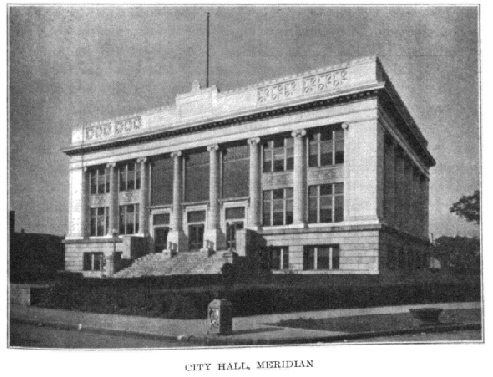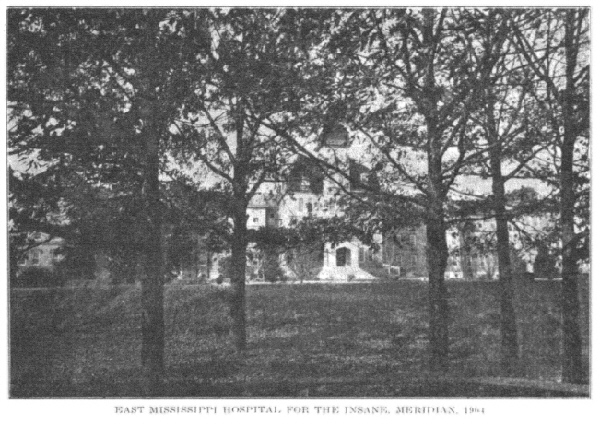.
Lauderdale
County

LAUDERDALE COUNTY
CHAPTER XLVI, pages 762 - 769
Lauderdale County, one of the richest and
most populous counties in the State, was established December 23, 1833,
while Charles Lynch was acting-governor. It has a land surface of 700 square
miles, and is located about the middle of the eastern border of the State
next to the Alabama line. It received its name in honor of Col. James Lauderdale,
of the War of 1812. By the original act it embraced "all the territory
within townships 5, 6, 7 and 8, of ranges 14, 15, 16, 17, 18 and 19," and
has an area of about 19 townships. It is bounded on the north by the county
of Kemper, on the east by Choctaw and Sumter counties, Alabama, on the
south by Clarke County, and on the west by Newton County.

Its early county seat was located
at Marion until 1866; at Marion Station from 1866 to 1870; it was then
removed to Meridian, the present county seat. In addition to the old county
seat of Marion, the towns of Alamutcha and Daleville, and the villages
of Sageville and Chunkeyville, were settled at a very early date in the
history of the county. All four towns are now extinct. Alamutcha was once
an Indian village, situated not far from Kewanee. Daleville is now known
as Lizelia, and was about ten miles northwest of Meridian; it was named
for Gen. Sam Dale, who first settled there. A few miles distant is Cooper
Institute, now known as Daleville. Sageville was near the present station
of Okatibbee, on the Mobile & Ohio railroad; E.J. Rew and Abram Burwell
were citizens of the old village. Chunkeyville was absorbed by Chunkey
Station, on the Alabama & Vicksburg railroad. Before the war, Lauderdale
Springs was a popular health resort.
No city in the State can show a more remarkable
growth since the War than Meridian. Up to 1854, it was a junction point,
whose very name was in dispute; in 1866, its first factory was established—a
foundry and machine shop. Its growth was then steady, being interrupted
only by a number of disastrous fires, and by the great fever epidemic of
1878. The superior transportation facilities of the county, afforded by
the numerous roads which cross its borders, and its great natural advantages
of soil, climate and forests, assure to this county a continuance of its
remarkable growth in wealth and prosperity. It is well watered by numerous
small creeks and streams, which are for the most part head waters of the
Chickasawhay River, or small branches of the Tombigbee, and it is well
timbered with pine, oak, hickory, gum, beech, chestnut, poplar and sycamore,
which are being rapidly worked up by its numerous mills and factories.
It is one of the few counties in the State where the value of the manufactured
products is greatly in excess of that of the farms. The soil, however,
produces good crops of cotton, corn, sugar cane, oats, peas, potatoes,
vegetables and fruits of all kinds, the last two items being extensively
raised for market, and the live stock industry is in a flourishing condition.

In 1880, the population of Meridian,
the notable manufacturing center, was 4,000; in 1900, 14,000, and in 1920,
23,000. It is the industrial center of eastern Mississippi and vies with
the capital of the State in population, manufactures and general progress.
In 1919, more than 2,000 of its people were employed in its manufactories,
numbering 54. The value of their products was $9,589,000. In the county
at large the industrial output amounted to $10,736,000.
Meridian is the most important railroad
center in the eastern part of the State, being the junction of the Mobile
& Ohio, the New Orleans & North Eastern, the Alabama & Vicksburg,
the Alabama & Great Southern and the St. Louis & San Francisco
(the Kansas City, Memphis & Birmingham line). The city is modern in
every respect, with not only business, commercial and industrial establishments
of modern type, but with excellent schools, fine churches and handsome
public buildings.
The location of Meridian, in 1854, was
the result of the proposed crossing of the Mobile & Ohio by the Alabama
& Vicksburg, then known as the Vicksburg & Montgomery railroad.
Cotton and corn fields occupied its present site, surrounded by oak and
pine forests over clay hills and bottomlands of the head waters of the
Chickasawhay. Richard McLamose possessed most of the lands and his plantation
home was the only notable residence in the vicinity. So little did the
Mobile & Ohio regard the point for a while, that it was with difficulty
persuaded to put in even a switch for a flag station; and when it did,
called the place "Sowashee Station," from a creek hard by. L.A. Ragsdale,
meanwhile, had bought out R. McLamose, and John T. Ball had purchased a
tract of 80 acres, and both parties immediately began to lay off town lots.
They were the pioneers. Mr. Ragsdale’s plat was for "Ragsdale City"; Mr.
Ball’s for "Meridian", he having first secured a postoffice by that name.
The postoffice name was adopted for the charter, secured by L.S.O.G. Greer
from the legislature, January 10, 1860, when the city of Meridian became
a legal corporation. It was several years before the Vicksburg road, then
known as the "Southern", made its junction, being delayed by having to
tunnel the Tallahata ridge. Meanwhile, part of what is now the A. G. S.
was finished to York, Alabama, twenty-seven miles. This road made connection
with the Selma branch soon after the declaration of the war as a military
necessity.
When the war broke out between the states,
in 1861, Meridian was a mere village with three or four stores, two or
three hotels and a shingle machine. There were two churches, Baptist and
Methodist, with a union Sunday school. Near where the Insane Asylum now
stands, a good sized academy had been built, and the school was in full
operation. But things changed. The city became a military camp and in due
time was division headquarters of the Confederate army. Early in the year
1864, Gen. W.T. Sherman, of the Federal army, made his raid to Meridian.
Gen. Leonidas Polk, who had been the Episcopal bishop of Louisiana was
in command. Having too small a force to meet the invaders, he was compelled
to fall back to Demopolis, the enemy taking possession of the surrounding
territory. Railroads were torn up for miles in every direction and many
houses were burned. All the grist mills were destroyed, and after the Federal
troops departed, women and children were without food for many days; but
no direct personal injury was inflicted.
The collapse of the Confederacy came in
April, 1865, and Meridian became a main point for issuing paroles. Everything
was done quietly, but in sadness. No complaints were made until the days
of reconstruction. Notwithstanding the troubles of that period, however,
the city began to grow. Mercantile establishments were multiplied, a bank
was started, and factories began to be built. But friction came, resulting
in the riot of 1871, and the reorganization of the municipal government.
Soon after the riot a census was taken of the city proper by the board.
The population proved to be only 3,881, which was not made public. Meanwhile,
the first cotton mill was established; but just as it began to pay, it
was accidentally destroyed by fire, which was a real calamity. Failure
of the A. & C. railroad and the burning of its shops had already cast
a gloom on business, but the sash and blind factory and other industries
soon filled up the gaps. In 1875, the burning of the Phoenix hotel, the
most imposing building in the city at the time, was a most unfortunate
affair. A period of depression was followed by the fever epidemic of 1878,
which almost depopulated the town; but the following year was noted for
a general advance in prosperity. The most encouraging feature was the proposed
road to New Orleans, in course of construction, and completed in 1883,
the shops being located in the city. Great credit is due Capt. W.H. Hardy,
then of this city, for the building of the N. O. & N. E. railroad,
and for the introduction of a second National Bank. He and Mr. C.W. Robinson
were prominent in the work of establishing industries and improving the
city. A little to the northwest the East Mississippi Insane Asylum was
built, now surrounded by beautiful grounds. In educational matters Meridian
has always taken a lively interest, which has steadily increased. A very
destructive fire occurred in 1882, which swept away quite a number of blocks
and residences, and the Presbyterian house of worship.
One of Meridian’s disasters, which it has
successfully surmounted, was the cyclone of March 3, 1906, which destroyed
the large hall of the Railroad Young Men’s Christian Association, the large
fertilizer factory, two or three blocks of stores, many residences, and
two white and three colored churches, and killed or injured about 50 persons.
Within the past twenty years, the city
has overcome every disaster and has taken on new life. Electric car lines,
electric lights, improvements of streets and sidewalks, the installation
of up-to-date systems of sewage disposal and water distribution and numerous
other advances along modern lines, have made Meridian one of the most progressive
cities of Mississippi, if not of the South. The official forces of the
city are known to be very strict and are no respecter of persons. When
confronted with even the suspicion of wrongdoing the "millionaire" and
the "ragged coat" receive identically the same treatment under the law.
Outside of Meridian, the centers of population
in Lauderdale County are small. The railroad towns and stations may be
mentioned as Lauderdale, Lockhart, Marion, Toomsuba, Russell, Arundel,
Savoy, Meehan, Graham, Kewanee, Lost Gap and Bonita.
The county has large claims to agricultural
superiority as well as industrial supremacy. Its farm property is valued
in the 1920 census at $8,169,000, and its crops for the previous year at
$2,117,000. But it is in the raising of small fruits and vegetables that
Lauderdale has made the most pronounced advances. There is no county in
the State which raises strawberries in such abundance, her product for
1919 being 246,000 quarts, while the crop of vegetables brought $542,000
into the treasuries of the farmers.
With the exception of a slight decrease
in 1920, as compared with the figures of 1910, the population of Lauderdale
County has consistently advanced. It was 8,717 in 1850, 13,432 in 1870,
29,661 in 1890, 46,919 in 1910, and 45,897 in 1920.
Return to
County History Index
MSGenWeb Home
Source:
Mississippi The Heart of the South - By Dunbar Rowland, LL.D - Director
of the Mississippi State Department of Archives and History. Vol.
II Illustrated. Chicago-Jackson; The S. J. Clarke Publishing
Company, 1925. Public Domain
Copyright Notice: All files
and photographs on this site are copyrighted by their creator and/or contributor,
unless otherwise noted. They may be linked to but may not be reproduced
on another site without specific permission from The MSGenWeb State Coordinator
or the Assistant State Coordinator, and/or their contributor. Although
public information is not in and of itself copyrightable, the format in
which they are presented, the notes and comments, etc., are. It is however,
quite permissible to print or save the files to a personal computer for
personal use ONLY.
  
|






